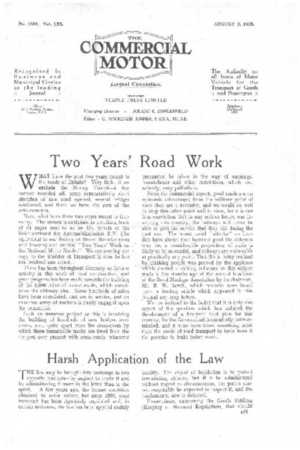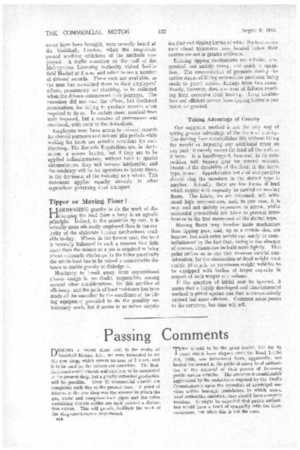Harsh Application of the Law
Page 19

Page 20

If you've noticed an error in this article please click here to report it so we can fix it.
THE law may be brought into contempt in two opposite manners—by neglect to apply it and by administering it more in the letter than in the spirit. A few years ago, the former condition obtained to some extent, but since 1930, road transport has been rigorously regulated and, in certain instances, the law has been applied unduly harshly. The object of legislation is to protect Jaw-abiding citizens, but if it be administered without regard to circumstances, the public cannot reapnably be expected to respect it, and the fundamental aim is defeated.
Prosecutions, concerning the Goods Vehicles (Keeping of Records) Regulations, that should never have been brought, were recently heard at the Guildhall, London, when the magistrate passed scathing criticisms of the methods employed. A traffic examiner on the staff of the Metropolitan Licensing Authority visited Smithfield Market at 2 a.m. and asked to see a number of drivers' records. These were not available, as the men had submitted them to their employers' offices, presumably for checking, to be collected when the drivers commenced their journeys. The examiner did not visit the offices, but instituted prosecutions for failing to produce records when required to do so. In certain cases, nominal fines were imposed, but a number of summonses was dismissed, with costs to the defendants.
Employers must have access to drivers' records for clerical purposes and drivers' idle periods while waiting for loads are suitable occasions for such checking. The Records Regulations are, in themselves, a severe burden, but if they are to be applied indiscriminately, without heed to special circumstances, they will become intolerable, and the tendency will be for operators to ignore them, to the detriment of the industry as a whole. This statement applies equally strongly to other regulations governing road transport.
Tipper or Moving Floor ?
HARNESSING gravity to do the work of dis'charging the load from a lorry is an age-old principle. Indeed, in the primitive tip cart, it is actually more efficiently employed than in the majority of the elaborate tipping mechanisms available to-day. Where, in the former case, the load is normally balanced in such a manner that little more than the release of a pin is required to bring about automatic discharge, in the latter practically the whole load has to be raised a considerable distance to enable gravity to dislodge it.
Hesitancy to break away from conventional chassis design is, no doubt, responsible, among several other considerations, for this sacrifice of efficiency, and the path of least resistance has been made all the smoother by the excellence of the lifting equipment provided to do the possibly unnecessary work, but it seems to us rather surpris ing that end-tipping lorries of which the bodies can rock about transverse axes located below their centres are not in greater evidence.
Existing tipping mechanisms are reliable, economical, not unduly heavy, and quick in operation. The concentration of pressure during the earlier stages of lifting necessitates provision being made to guard against damage from this cause. Rarely, however, does one hear of failures resulting from excessive local loading. Long troublefree and efficient service from tipping lorries is just taken for granted.
Taking Advantage of Gravity Our suggested method is not the only way of taking greater advantage of the force of gravity. The moving floor accomplishes this without lifting the weight or imposing any additional stress on any part ; it merely moves the load off the end, as it were. It is handicapped, however, in its competition with tipping gear for several reasons. Doubt of the durability of the floor, in the fabric type, is one. Apprehension lest dust and particles should clog the members in the slatted type is another. Actually, there are few forms of load which cannot with impunity be carried on moving floors. The fabric, we are informed, will withstand high temperatures, and, in any case, it is easy and not unduly expensive to renew, whilst successful precautions are taken to prevent interference in the free movement of the slatted type.
Moving floors may involve more mechanism than tipping gear, and, up to a certain size, are heavier, but such extra weight can surely be counterbalanced by the fact that, owing to the absence of stresses, chassis can be built more lightly. This point strikes us as one that deserves careful consideration, for the elimination of dead weight must enable 30-m.p.h. or maximum-weight vehicles to be equipped with bodies of larger capacity in respect of both weight and volume.
If the question of initial cost be ignored, it seems that a highly developed and time-honoured method is pitted against one that is comparatively untried but more efficient. Common sense points to the certainty, but time will tell.












































































